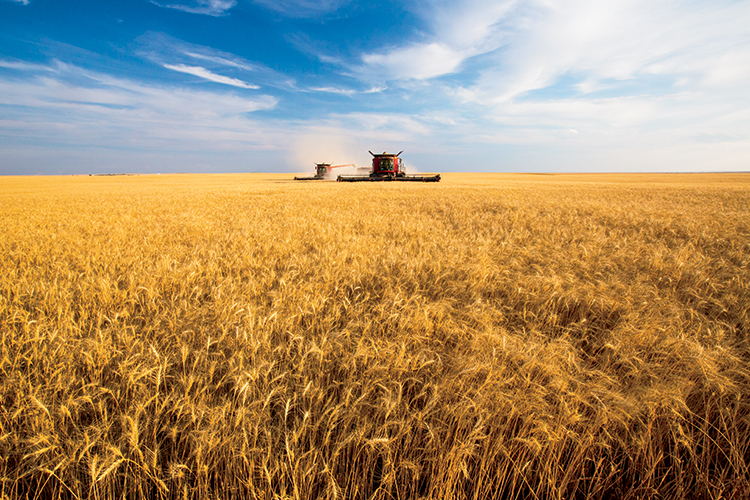Home > Montana > Montana Crops & Livestock > Montana Produces Bushels of the Best Wheat
Montana Produces Bushels of the Best Wheat

Quantity versus quality? Montana wheat producers have settled that debate by excelling at both.
In 2014, Montana farmers harvested 209.4 million bushels of wheat, ranking the state No. 3 nationally in total production. With an estimated value of more than $1 billion, according to the National Agricultural Statistics Service, wheat is second only to cattle in agricultural revenue in Montana.
The state’s wheat is of such high quality that it’s considered “improvement” wheat, which means it is sometimes added to wheat grown elsewhere in order to improve the overall quality.
“It’s important for our producers to receive a premium for what they grow, so the focus is on quality,” says Cassidy Marn of the Montana Wheat and Barley Committee. “Some foreign customers will buy wheat at a lower quality, and then purchase Montana wheat to improve the specifications.”
“Our wheat sets the bar for quality,” says Frank Schoonover, a wheat producer and Wheat and Barley Committee member. Schoonover’s Hemstad Farms, founded by his in-laws, is located in the Golden Triangle, a seven-county area, including Great Falls, Shelby and Havre that grows approximately 45 percent of the state’s wheat crop each year.
Wheat quality is based primarily on weight, enzymatic activity, protein and baking performance, Schoonover says, and Montana growers exceed the baseline in every category.
A Global Appetite
An estimated 80 percent of the wheat grown in Montana is exported, with the majority going to Asia. Japan is the top buyer of Montana wheat followed by the secondary markets of Taiwan, South Korea, the Philippines and Indonesia.
“Our geographic location close to the Pacific Northwest is a bonus,” Marn says. “We have the infrastructure in place to keep the industry strong. Japanese companies have invested in new elevators and shuttle facilities in Montana over the past eight years, signaling their interest in continued purchase of our state’s wheat crop.”
Asian markets choose Montana’s hard red spring wheat due to its high protein, milling and baking characteristics. The spring wheat works well in breads and is an exceptional blending wheat to improve the quality of other classes.
Hard red winter wheat is used in Asian noodles, hard rolls, flat breads and general-purpose flour. It also blends well with other wheat varieties.
Montana producers grow five of the six classes of wheat. In addition to winter and spring wheats, durum is the third primary class grown in the state, and to a lesser degree hard white and soft white, but no soft red.

Durum Boosts Economy
It’s the quality and quantity of the state’s durum that drew Pasta Montana to the state. The gluten strength and high protein of the durum grown in the Golden Triangle makes it perfect for milling into semolina – or purified wheat middlings – at the General Mills facility located adjacent to the Pasta Montana plant. The proximity allows Pasta Montana access to the freshest semolina for its products. The company also works with local grain growers to ensure crops have the specific characteristics valued by customers.
“The color, protein structure and gluten content of durum lends itself very well to making superior pasta,” says Randy Gilbertson, Pasta Montana’s chief operating officer and general manager. “All we use is durum wheat, and we feel Montana produces some of the highest-quality durum in the world. That’s the reason the founders of the company put the plant here, and that’s the reason we still thrive here.”
Served in high-end restaurants, the company’s products are shipped around the country.
Pasta Montana consumes about 1.5 million bushels of durum wheat annually, has the capacity to produce approximately 70 million pounds of pasta and employs approximately 100 workers.
![Wheat [INFOGRAPHIC]](https://eadn-wc01-4177395.nxedge.io/wp-content/uploads/2020/05/Screen-Shot-2015-03-11-at-12.09.54-PM.png)




![Wheat [INFOGRAPHIC]](https://eadn-wc01-4177395.nxedge.io/wp-content/uploads/2020/05/Screen-Shot-2015-03-11-at-12.08.22-PM.png)